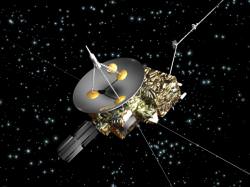Continuing on its epic journey around the Sun, Ulysses has reached the Sun’s north pole just in the nick of time. In fact, its timing couldn’t be better, just as the Sun begins “Solar Cycle 24”. The probe is in a unique orbit, passing over the solar north and south poles, out of the ecliptic plane of the solar system, giving it an unprecedented view of parts of the Sun we cannot observe on Earth. “Graveyards for sunspots” and mysterious coronal holes lurk in these regions and Ulysses will be perfectly placed, directly above.
The joint NASA and ESA Ulysses mission has been a resounding success in its 18 years of operation since launch on board Space Shuttle Discovery (STS-41) in October 1990. The intrepid spacecraft was helped on it’s way by a gravitational assist by the planet Jupiter which flung it over the poles of the Sun. Quietly travelling in a perpendicular orbit (space missions and the planets usually orbit around the Sun’s equator), Ulysses has been measuring the distribution of solar wind particles emanating from latitudinal locations for one and a half orbits.
As Ulysses passes over the north polar region, the Sun will be observed during a period of minimum activity at this location for the first time. The poles of the Sun are of particular interest to scientists as this is where the fast solar wind originates from open magnetic field lines reaching into space. The dynamics of solar material in this location provides information on how the Sun interacts with interplanetary space and how the solar wind is generated. Observing the solar wind at “solar minimum” will be of massive interest as it may provide some answers as to why the solar wind is accelerated hundreds of kilometers per hour even when activity is at its lowest.
“Just as Earth’s poles are crucial to studies of terrestrial climate change, the sun’s poles may be crucial to studies of the solar cycle.” – Ed Smith, Ulysses project scientist, NASA Jet Propulsion Laboratory.
The dynamics of low altitude magnetic fields in polar regions are also a focus for interest. As 11-year solar cycles progress, sunspot population increase near the solar equator. As the magnetic field is “wound up”, sunspots (and their associated magnetic flux) drift toward the poles where they slowly disappear as the old magnetic field sinks back into the Sun, quite accurately described as sunspot graveyards. Understanding how this cycle works will help to reveal the secrets of the solar cycle and ultimately help us understand the mechanisms behind Space Weather.
Source: NASA Featured News


Maybe we can harness the sun’s solor wind to help us travel space even faster and further….RIDE ON Ulysses….RIDE ON!!
This should be awesome,can’t wait for their conclusions
ESA/NASA have certainly had their moneys-worth out of this old fella! What a terrific record!
Congrats to all concerned.